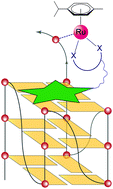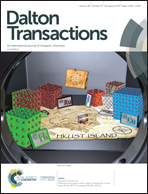Ruthenium–arene complexes bearing naphthyl-substituted 1,3-dioxoindan-2-carboxamides ligands for G-quadruplex DNA recognition†
Abstract
Quadruplex nucleic acids – DNA/RNA secondary structures formed in guanine rich sequences – proved to have key roles in the biology of cancers and, as such, in recent years they emerged as promising targets for small molecules. Many reports demonstrated that metal complexes can effectively stabilize quadruplex structures, promoting telomerase inhibition, downregulation of the expression of cancer-related genes and ultimately cancer cell death. Although extensively explored as anticancer agents, studies on the ability of ruthenium arene complexes to interact with quadruplex nucleic acids are surprisingly almost unknown. Herein, we report on the synthesis and characterization of four novel Ru(II) arene complexes with 1,3-dioxoindan-2-carboxamides ligands bearing pendant naphthyl-groups designed to bind quadruplexes by both stacking and coordinating interactions. We show how improvements on the hydrolytic stability of such complexes, by substituting the chlorido leaving ligand with pyridine, have a dramatic impact on their interaction with quadruplexes and on their cytotoxicity against ovarian cancer cells.



 Please wait while we load your content...
Please wait while we load your content...